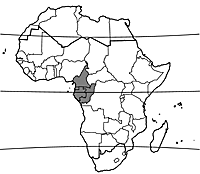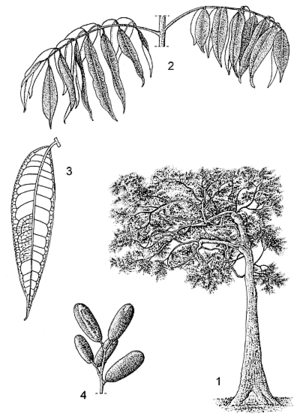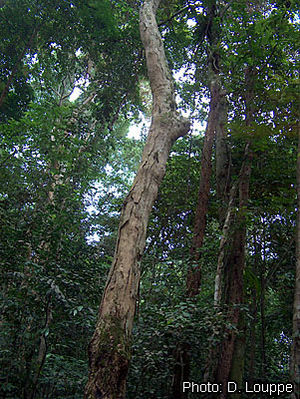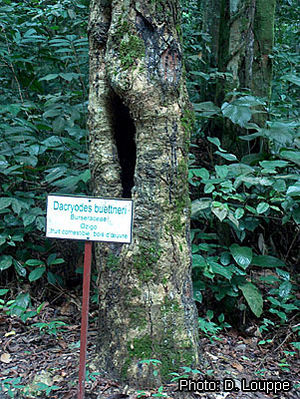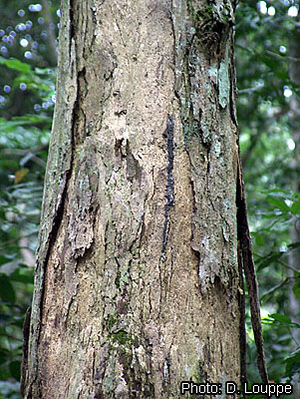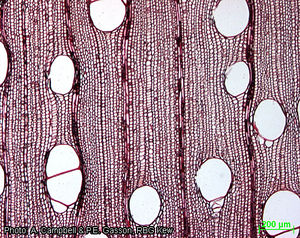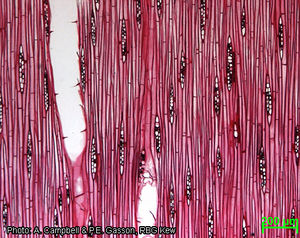Dacryodes buettneri (PROTA)
Introduction |
Dacryodes buettneri (Engl.) H.J.Lam
- Protologue: Bull. Jard. Bot. Buitenzorg, ser. 3, 12: 336 (1932).
- Family: Burseraceae
Synonyms
- Pachylobus buettneri (Engl.) Engl. (1897).
Vernacular names
- Ozigo, assia (En).
- Ozigo (Fr).
Origin and geographic distribution
Dacryodes buettneri is a characteristic species of western Central Africa, where its natural distribution is very similar to that of Aucoumea klaineana Pierre (okoumé). It occurs mainly in Gabon, where it can be found throughout the country, and Equatorial Guinea. Small populations have been recorded from southern Cameroon, around the loop of the Dja river, as well as along the southern border, from Campo to Ambam and south of Djoum; from here its distribution extends into the Souanké and Mbomo regions in northern Congo. Dacryodes buettneri is also present in southern Congo (Mayombe).
Uses
The wood (trade name: ozigo) is important in Gabon and Equatorial Guinea. It is especially used for plywood (for boxes, packaging or furniture) and no longer used much in massive form, although it can be sawn into planks for interior joinery, furniture, carpentry, moulding, parquetry, interior stairs, panelling, vehicle bodies, boat hulls, boxes and poles. Locally, the wood is used for making canoes. It is suitable for papermaking.
In Gabon Dacryodes buettneri is an important fruit tree. Its fruits resemble those of the butter fruit tree (Dacryodes edulis (G.Don) H.J.Lam), but they are smaller. The oil-rich pulp is locally consumed after soaking the fruit in boiling water for about one minute.
The powdered bark is used medicinally for the treatment of burns. The resin is applied to abscesses, and it is used as a disinfectant and astringent.
Production and international trade
The volume of ozigo exported from Gabon has decreased since the late 1990s, from 160,000 m³ in 1994–1995, through 61,000 m³ in 1999, to about 20,000 m³ and 30,000 m³ in 2004 and 2005, respectively. In 2005 it occupied 9th place in the list of the most important export timbers of Gabon. As an export timber, ozigo is much less valued and less traded than okoumé. The average port price and free-on-board price are about Frs CFA 50,000/m³ (US$ 93/m³) and Frs CFA 61,000/m³ (US$ 113/m³), respectively. The latter is 35% lower than the price of okoumé. According to ITTO statistics, Gabon exported about 1000 m³ of sawn ozigo in 2004, at an average price of US$ 243/m³, and also 1000 m³ in 2005, at an average price of US$ 277/m³. Despite the decline in international trade in ozigo, it must be stressed that the wood is still much exploited for the interior market in Gabon; numerous sawmills produce planks and rafters for construction purposes. In 1999 the remaining standing volume of ozigo was estimated at 40 million m³. In Cameroon only about 200 m³ of Dacryodes buettneri wood was exploited in 1998–1999.
The fruits are collected in the forest but not much traded, although they can sometimes be found on local markets.
Properties
The heartwood is pinkish white to grey-cream; it is not distinctly demarcated from the 5–9 cm wide sapwood. The grain may be interlocked, crossed or straight; the texture is rather coarse. The wood contains 0.1–0.5% silica.
The wood is medium-weight, with a density of 500–700 kg/m³ at 12% moisture content. It dries rapidly, generally without problems, but drying of thin pieces and plywood sheets should be done carefully, because of the risk of deformation due to the frequent presence of interlocked grain. The rates of shrinkage from green to oven dry are 5.0–7.4% radial and 6.3–9.8% tangential. Once dried, the wood is moderately stable in service. The wood is moderately hard, elastic and resistant to shock. At 12% moisture content, the modulus of rupture is 101–161 N/mm², modulus of elasticity 8300–13,900 N/mm², compression parallel to grain 38–70 N/mm², compression perpendicular to grain 6.5 N/mm², cleavage 13–25 N/mm and Chalais-Meudon side hardness 2.2–5.0.
The high silica content and the presence of interlocked grain may cause problems during processing and make special equipment necessary. The wood saws easily, but with serious blunting effect, necessitating the use of stellite teeth and tungsten carbide tools. The working angle should be reduced as much as possible. Quartersawn pieces have a ribbon-like aspect and are sometimes marbled; flat-sawn pieces have better surfaces after processing. The peeling properties are good. Although the wood can be peeled without prior steaming, steaming is recommended to improve the quality of the sheets obtained; it is not recommended or useful for slicing. Gluing properties are good, but problems may arise with glues based on phenol-formol. Nailing, screwing and finishing properties are good.
Ozigo is not durable. It is liable to attack by fungi, termites and other insects, but resistant to marine borers. The wood is not recommended for temporarily or permanently humid conditions. It is difficult to impregnate with preservatives.
The wood contains: cellulose 54.4%, pentosans 15.7%, lignin 29.9% and ash 0.9%. The solubility in 1% NaOH is 15.4%.
Distillation of the resin yielded 6.7% essential oil, with as main components terpinen-4-ol (27%), p-cymene (19%) and α-pinene (13%). The essential oil showed in-vitro antioxidant activity and antibacterial activity against a range of bacteria. The fruit pulp is rich in oil, like that of Dacryodes edulis. The main components in the essential oil of the fruit are α-pinene (29%) and limonene (23%).
Adulterations and substitutes
The wood is difficult to distinguish from that of other Dacryodes species, such as igaganga (Dacryodes igaganga Aubrév. & Pellegr.), ossabel (Dacryodes normandii Aubrév. & Pellegr.) and safukala (both Dacryodes pubescens (Vermoesen) H.J.Lam and Dacryodes heterotricha (Pellegr.) H.J.Lam).
Description
- Dioecious, medium-sized to large tree up to 40(–50) m tall; bole branchless for up to 20 m, up to 150 cm in diameter, often sinuous or with knobs, base thickened; outer bark golden yellow, flaking, inner bark pinkish, when cut slowly exuding a translucid resin with a terebinth-like odour; crown much-branched, with entangled branches and dark foliage having a brown tint when seen from below.
- Leaves alternate, imparipinnately compound with 5–8(–10) pairs of leaflets; stipules absent; rachis 10–30 cm long, reddish brown hairy; petiolules 8–10(–15) mm long, channelled; leaflets opposite, oblong-lanceolate to lanceolate, 12–20 cm × 3–4 cm, base asymmetric, apex acuminate, upper surface dark green and shiny, lower surface reddish brown stellate hairy, pinnately veined with 10–15 pairs of lateral veins.
- Inflorescence an axillary or terminal panicle 30 cm × 4 cm, with cymose ramifications, stellate hairy.
- Flowers unisexual, regular; pedicel 1–2 mm long, hairy; male flowers with 3 ovate sepals 2–2.5 mm long, hairy outside, glabrous inside, petals 3, 2.5–3 mm long, hairy outside, stamens 6, with filaments 1 mm long, ovary rudimentary; female flowers similar but somewhat larger, with petals 3.5 mm long, ovary superior, ovoid, glabrous.
- Fruit an oblong-ellipsoid drupe 2–4 cm × 1–1.5 cm, purplish blue at maturity, pulp fleshy, up to 3 mm thick, green-yellow, stone with thin and smooth wall, 1-seeded.
- Seed with cotyledons palmately divided into 5 segments.
Other botanical information
Dacryodes comprises about 40 species, occurring in the American, Asian and African tropics. In Africa, about 20 species have been found, all of section Pachylobus. Gabon seems richest with approximately 10 species. Dacryodes buettneri is easily recognized by its hairy leaflets, coloured reddish brown below.
Anatomy
Wood-anatomical description (IAWA hardwood codes):
- Growth rings: 2: growth ring boundaries indistinct or absent.
- Vessels: 5: wood diffuse-porous; 13: simple perforation plates; 22: intervessel pits alternate; 23: shape of alternate pits polygonal; 26: intervessel pits medium (7–10 μm); 32: vessel-ray pits with much reduced borders to apparently simple: pits horizontal (scalariform, gash-like) to vertical (palisade); 42: mean tangential diameter of vessel lumina 100–200 μm; 46: ≤ 5 vessels per square millimetre; 47: 5–20 vessels per square millimetre; 56: tyloses common.
- Tracheids and fibres: 61: fibres with simple to minutely bordered pits; 65: septate fibres present; 69: fibres thin- to thick-walled.
- Axial parenchyma: 75: axial parenchyma absent or extremely rare; 78: axial parenchyma scanty paratracheal; 92: four (3–4) cells per parenchyma strand; 93: eight (5–8) cells per parenchyma strand.
- Rays: 97: ray width 1–3 cells; 106: body ray cells procumbent with one row of upright and/or square marginal cells; 115: 4–12 rays per mm.
- Mineral inclusions: 159: silica bodies present; 160: silica bodies in ray cells; (161: silica bodies in axial parenchyma cells).
Growth and development
Germination takes 30–37 days. The seeds can germinate in forest undergrowth and seem to tolerate lower light intensities than those of okoumé. The seeds may form dense mats below mother trees, but many of them disappear rapidly. Some seedlings may persist in forest undergrowth for several years, but more light seems necessary for subsequent growth. Young shoots of small plants have a characteristically pink colour. In mixed plantings with other species in Ekouk (Gabon), the survival rate of Dacryodes buettneri was 30–70% after 3 years, without much mortality afterwards. When 10 years old, the trees had an average bole diameter of 8–9 cm. Although they were in good health, all trees had a sinuous bole. In Lopé (Gabon) the annual increase in bole diameter was 4.5 mm in dense forest and 6.8 mm in more open Marantaceae forest.
In north-eastern Gabon most trees seem deciduous, but phenological studies over long periods and with a sufficient number of individuals are lacking. Leaf loss has been observed in July–August, December–January and April. The trees remain leafless for less than a month only.
In north-eastern Gabon flowering sometimes occurs in March–April, but mostly in September–November. Fruiting is from July to March, with a high production of ripe fruits in September–November and February–March. It takes (3–)4–5(–6) months between the onset of flowering and the start of fruit production. The few data available from Cameroon indicate that flowering in this country is in March, and fruiting in September. Pollination is mainly by insects. The trees fruit massively approximately every 3 years; fruit abortion is common. Seed dispersal is mainly by animals, the fruits being eaten by numerous birds, squirrels and monkeys.
Ecology
Dacryodes buettneri occurs in dense evergreen humid lowland forest (up to 700 m altitude). It grows well on well-drained soils in equatorial or subequatorial climates with an average annual rainfall of 2000–3000 mm. It is always less abundant near the coast and on sandy soils than somewhat further inland and on clayey soils. In Gabon it is a tree of the upper forest layer, most common in the eastern part of the coastal sedimental basin in forests with Aucoumea klaineana and Desbordesia glaucescens (Engl.) Tiegh., and in the undulating land of the central part of the country, in forest with Desbordesia glaucescens and various Caesalpiniaceae. In the north-eastern part of the country it is less common, although it is locally abundant. In the Lopé national park in central Gabon, Dacryodes buettneri is the second most characteristic species of the upper forest layer, after Aucoumea klaineana; the density is 2.7 trees with a bole diameter over 70 cm per ha in dense forest, against 0.7 trees/ha in more open Marantaceae forest. The tree is generally common in old secondary forest, often in groups. Like Aucoumea klaineana, it behaves as a heliophyte, reproducing in old clearings, but less effectively so than Aucoumea klaineana. Dacryodes buettneri has also been observed in young secondary forest, under Musanga cecropioides R.Br. or Xylopia aethiopica (Dunal) A.Rich.
Propagation and planting
Dacryodes buettneri is only occasionally planted, mostly in home gardens. The only known trials and plantings have been realized in Gabon (Ninghé-ninghé, M’voum and Bokoué). Stumps will sprout after 4–8 months, with sprouts from the base being more vigorous than those higher on the stump. Unsuccessful experiments with macro cuttings have been carried out in Makokou experimental station (Gabon).
Management
No management practices of Dacryodes buettneri are known, although trees are sometimes maintained in home gardens. During clearing, trees that are considered cumbersome are felled. They are not conserved like other species which are more highly valued, such as Irvingia gabonensis (Aubry-Lecomte ex O’Rorke) Baill., or of which the wood is harder, such as Desbordesia glaucescens (Engl.) Tiegh. Furthermore, if an ozigo tree in the forest bears fruits abundantly, it may be felled to facilitate harvesting.
Diseases and pests
In Gabon desiccation of the crown has been observed in young plantations, but the cause is not clear. Elephants sometimes eat the young shoots and bark. Various predators may destroy the seeds by eating the fruits that have fallen on the ground.
Harvesting
In natural forest the average exploitation intensity of ozigo is not more than 1–2 trees/ha, but where the species is locally abundant the intensity may be much higher. The boles are exploited when they have a diameter at breast height of over 70 cm.
Yield
Ozigo logs have an average diameter of 70–100 cm. The mean wood volume of exploited trees is 7–8 m³.
Handling after harvest
The logs float in water and can be transported by river. It is recommended to treat the wood against fungi and insects and to avoid humid conditions by storing the wood under shelter and not in contact with soil. Fruits collected in the forest are normally consumed directly, but sometimes the pulp is conserved for later usage by drying over a fire after the seed has been removed.
Genetic resources
Information on the genetic variation of Dacryodes buettneri is not yet available, and no germplasm collection is known. In view of its abundance, the species does not seem threatened with genetic erosion, except in some parts of its distribution area. In Cameroon, for instance, it is considered threatened due to forest exploitation pressure and the relatively low number of trees.
Prospects
The wood of Dacryodes buettneri is considered a substitute of okoumé for the production of plywood. Although its exploitation for international trade is decreasing, it is still among the 10 main export timbers of Gabon. Furthermore, its utilization in joinery is currently well developed in the interior market of Gabon, indicating that the resource remains under considerable pressure. In spite of its importance as a source of wood, fruits and traditional medicines, the species has not been the object of research. Its biology is poorly known and it is not intentionally included in traditional agroforestry systems. It seems useful to establish collections of genetic resources, particularly in Cameroon, where Dacryodes buettneri is considered a threatened species. This may also become the case in Gabon if its exploitation remains mainly in the hands of sawmillers and small exploiters.
Major references
- Aubréville, A., 1948. Les Dacryodes (Pachylobus) et Santiria de l’ouest africain. Bois et Forêts des Tropiques 5: 342–348.
- Aubréville, A., 1962. Burséracées. Flore du Gabon. Volume 3. Muséum National d’Histoire Naturelle, Paris, France. pp. 53–95.
- Bolza, E. & Keating, W.G., 1972. African timbers: the properties, uses and characteristics of 700 species. Division of Building Research, CSIRO, Melbourne, Australia. 710 pp.
- CIRAD Forestry Department, 2003. Ozigo. [Internet] Tropix 5.0. http://tropix.cirad.fr/afr/ozigo.pdf. October 2007.
- Normand, D. & Mariaux, A., 1962. Peut-on distinguer les bois d’ozigo, des safoukala, igaganga et autres Dacryodes? Bois et Forêts des Tropiques 85: 33–40.
- Onana, J-M., 1998. Les Burséracées du Cameroun: taxonomie, biométrie foliaire et biologie. Thèse de doctorat 3ème cycle, Université de Yaoundé, Yaoundé, Cameroon. 267 pp.
- Vivien, J. & Faure, J.J., 1985. Arbres des forêts denses d’Afrique Centrale. Agence de Coopération Culturelle et Technique, Paris, France. 565 pp.
- White, L. & Abernethy, K., 1997. A guide to the vegetation of the Lopé Reserve, Gabon. 2nd edition. Wildlife Conservation Society, New York, United States. 224 pp.
- White, L., McPherson, G. & Abernethy, K., 1999. Dacryodes buettneri. Flowering Plants of Africa 56: 70–73.
- Wilks, C. & Issembé, Y., 2000. Les arbres de la Guinée Equatoriale: Guide pratique d’identification: région continentale. Projet CUREF, Bata, Guinée Equatoriale. 546 pp.
Other references
- ATIBT (Association Technique Internationale des Bois Tropicaux), 1986. Tropical timber atlas: Part 1 – Africa. ATIBT, Paris, France. 208 pp.
- Bourobou-Bourobou, H., 1994. Biologie et domestication de quelques arbres fruitiers de la forêt du Gabon. Thèse Université Montpellier II - Sciences et Techniques du Languedoc, Montpellier, France. 340 pp.
- Christy, P., Jaffré, R., Ntougou, O. & Wilks, C., 2003. La forêt et la filière bois au Gabon. Projet Aménagement Forestier et Environnement, Libreville, Gabon. 389 pp.
- Cordiez, F., 2000. Etude des mécanismes de régénération naturelle de l’agba (Gossweilerodendron balsamiferum Harms), l’azobé (Lophira alata Banks ex Gaertn.f.), le movingui (Distemonanthus benthamianus Baill.) et l’ozigo (Dacryodes buettneri (Engl.) H.J. Lam) au Gabon. FUSAGx, Gembloux, Belgium. 88 pp.
- Cravo, L., Perineau, F., Delmas, M. & Bessiere, J.M., 1992. Volatiles of the fruit of Dacryodes buettneri H.J. Lam and D. igaganga Aubrev. et Pellegr. (Burseraceae). Journal of Essential Oil Research 4(1): 95–96.
- CTFT (Centre Technique Forestier Tropical), 1961. Résultats des observations et des essais effectués au centre technique forestier tropical sur ozigo: Dacryodes buettneri H.J. Lam. Information technique No 77. Centre Technique Forestier Tropical, Nogent-sur-Marne, France. 5 pp.
- Daly, D.C. & Martínez-Habibe, M.C., 2002. Notes on Dacryodes Vahl, including a new species from the Rio Negro basin in Amazonia. Studies in neotropical Burseraceae. XI. Brittonia 54(4): 266–274.
- de Saint-Aubin, G., 1963. La forêt du Gabon. Publication No 21 du Centre Technique Forestier Tropical, Nogent-sur-Marne, France. 208 pp.
- Dowsett-Lemaire, F., 1996. Composition et évolution de la végétation forestière au Parc National d’Odzala, Congo. Bulletin du Jardin Botanique National de Belgique 65: 253–292.
- Gérard, J., Edi Kouassi, A., Daigremont, C., Détienne, P., Fouquet, D. & Vernay, M., 1998. Synthèse sur les caractéristiques technologiques des principaux bois commerciaux africains. Document Forafri 11. Cirad, Montpellier, France. 185 pp.
- Hecketsweiler, P., 1992. Phénologie et saisonnalité en forêt gabonaise. L’exemple de quelques espèces ligneuses. Thèse doctorat, Université Montpellier 2, France. 414 pp.
- InsideWood, undated. [Internet] http://insidewood.lib.ncsu.edu/search/. May 2007.
- Louis, A.M. & Fontès, J., 1996. Richesse floristique et biodiversité des forêts du Gabon. Exemple de la forêt littorale. In: Guillaumet, J.-L., Belin, M. & Puig, H. (Editors). Phytogéographie tropicale: réalités et perspectives. Orstom, Paris, France. pp. 182–191.
- Louppe, D., Deleporte, P., Vigneron, P. & Béhaghel, I., 1999. Projet OIBT PD 10/95 REV. 2 (F). Evaluation des essences indigènes de bois d’œuvre en vue du développement des plantations forestières au Gabon. Rapport final Assistance technique du CIRAD-Forêt, Libreville – Montpellier. 201 pp.
- Ngoye, A., 1994. Rapport de la mission de pré-collecte des semences d’Irvingia gabonensis au Gabon (du 22 août au 13 septembre 1994). Rapport IRET, Libreville, Gabon. 6 pp.
- Obame, L.-C., Koudou, J., Chalchat, J.-C., Bassolé, I., Edou, P., Ouattara, A.S. & Traore, A.S., 2007. Volatile components, antioxidant and antibacterial activities of Dacryodes buettneri H. J. Lam. essential oil from Gabon. Scientific Research and Essay 2(11): 491–495.
- Senterre, B., 2001. La phytogéographie des forêts denses de Guinée Equatoriale, avec une attention particulière aux forêts de Nsork. Systematics and Geography of Plants 71: 1087–1096.
- Takahashi, A., 1978. Compilation of data on the mechanical properties of foreign woods (part 3) Africa. Shimane University, Matsue, Japan, 248 pp.
- Vivien, J. & Faure, J.J., 1988. Fruitiers sauvages du Cameroun. Fruits Paris 43(9): 507–516.
- White, L., 2001. Forest-savanna dynamics and the origins of ‘Marantaceae forest’ in the Lopé Reserve, Gabon. In: Weber, B. & Vedder, A. (Editors). African rain forest ecology and conservation. Yale University Press, New Haven, United States. 141 pp.
Sources of illustration
- Aubréville, A., 1962. Burséracées. Flore du Gabon. Volume 3. Muséum National d’Histoire Naturelle, Paris, France. pp. 53–95.
- White, L. & Abernethy, K., 1997. A guide to the vegetation of the Lopé Reserve, Gabon. 2nd edition. Wildlife Conservation Society, New York, United States. 224 pp.
Author(s)
- G. Todou, Herbier National du Cameroun, B.P. 1601, Yaoundé, Cameroon
- C. Doumenge, CIRAD, Campus International de Baillarguet TA-C-36/D, F-34398 Montpellier cedex 5, France
Correct citation of this article
Todou, G. & Doumenge, C., 2008. Dacryodes buettneri (Engl.) H.J.Lam. In: Louppe, D., Oteng-Amoako, A.A. & Brink, M. (Editors). PROTA (Plant Resources of Tropical Africa / Ressources végétales de l’Afrique tropicale), Wageningen, Netherlands. Accessed 31 March 2025.
- See the Prota4U database.

